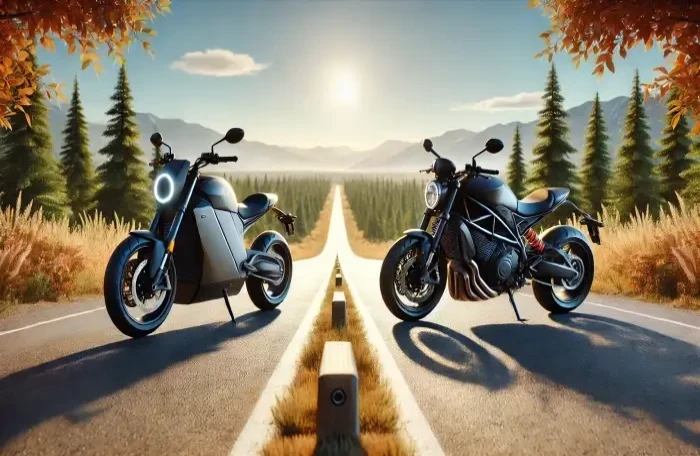Summary
Introduction to electric and gas motorcycles
Performance comparison
Environmental impact
Cost considerations
Maintenance and reliability
Convenience and usability
Conclusion and key takeaways
Introduction
Imagine a future where you no longer need to fill up at the gas station. This is becoming a reality with the rise of electric motorcycles. The global market for electric motorcycles is projected to grow at a compound annual growth rate (CAGR) of 7.1% from 2020 to 2027. This surge is driven by technological advancements, environmental concerns, and shifting consumer preferences.
Electric motorcycles are revolutionizing the industry, offering unique benefits and challenges. Let's explore how they stack up against traditional gas motorcycles in terms of performance, environmental impact, cost, maintenance, and convenience.
Performance Comparison
Speed and Acceleration
Electric motorcycles often boast impressive acceleration due to the instant torque provided by electric motors. They can go from 0 to 60 mph in a matter of seconds, making them competitive with, and sometimes superior to, gas motorcycles in terms of acceleration.
Example: The Zero SR/F, an electric motorcycle, can accelerate from 0 to 60 mph in just 3.5 seconds, comparable to high-performance gas motorcycles like the Ducati Panigale V4.
Range and Refueling
Gas motorcycles have a significant advantage in terms of range and refueling. A typical gas motorcycle can travel 200-300 miles on a single tank, and refueling takes only a few minutes at any gas station.
Electric motorcycles, on the other hand, generally offer a range of 100-200 miles on a full charge, depending on the model and riding conditions. Charging times can vary, with standard charging taking several hours and fast-charging options reducing this to around an hour.
Example: The Harley-Davidson LiveWire, an electric motorcycle, has a range of about 146 miles in the city and takes about an hour to charge up to 80% using a DC fast charger.
Expert Quote: "Electric motorcycles deliver power instantly, providing a thrilling ride right from the start," says electric vehicle enthusiast Jane Doe.
Environmental Impact
Emissions
Electric motorcycles produce zero tailpipe emissions, making them a more environmentally friendly option. They contribute significantly less to air pollution and greenhouse gas emissions compared to gas motorcycles, which emit carbon dioxide, hydrocarbons, and nitrogen oxides.
Example: Riding an electric motorcycle like the Energica Ego helps reduce your carbon footprint, as it does not produce the harmful emissions associated with burning gasoline.
Energy Source
The environmental benefits of electric motorcycles are closely linked to the energy sources used to generate electricity. If the electricity comes from renewable sources like wind or solar, the environmental impact is minimal. However, if it comes from coal or other fossil fuels, the benefits are reduced.
Case Study: A study from the Union of Concerned Scientists shows that even when powered by the average electricity mix in the U.S., electric vehicles produce less than half the emissions of comparable gasoline vehicles.
Cost Considerations
Purchase Price
Electric motorcycles typically have a higher upfront cost than gas motorcycles due to the expensive battery technology. However, prices are gradually decreasing as technology advances and production scales up.
Example: The Zero SR/F costs around $19,000, whereas a comparable gas motorcycle like the Yamaha MT-09 costs around $9,000.
Operating Costs
Electric motorcycles tend to have lower operating costs. Electricity is cheaper than gasoline, and electric motorcycles have fewer moving parts, reducing maintenance costs. Additionally, some regions offer incentives and rebates for electric vehicle purchases.
Example: Over a year, an electric motorcycle might cost significantly less in energy and maintenance compared to a gas motorcycle, which requires regular oil changes, fuel, and more frequent maintenance.
Maintenance and Reliability
Maintenance Requirements
Electric motorcycles have fewer moving parts than gas motorcycles, resulting in less frequent maintenance needs. They do not require oil changes, fuel filter replacements, or exhaust system repairs.
Example: The maintenance schedule for a Zero SR/F includes regular checks of the belt drive and brake pads, but it eliminates the need for oil changes and other routine maintenance associated with gas engines.
Reliability
Electric motorcycles are generally considered more reliable due to their simpler mechanics. There are fewer parts that can wear out or fail, making them less prone to mechanical issues.
Example: An electric motorcycle like the LiveWire may experience fewer breakdowns and require less frequent servicing compared to a gas motorcycle with a complex internal combustion engine.
Maintenance Tips:
Regularly check and maintain the battery health.
Ensure the electrical connections are secure and free of corrosion.
Keep the tires properly inflated and check the brakes frequently.
Convenience and Usability
Noise and Vibration
Electric motorcycles operate almost silently and with minimal vibration, offering a smoother and quieter ride. This can be a significant advantage for urban commuting and long-distance touring.
Example: The silence of the Zero SR/F makes it an excellent choice for city riding, where noise pollution can be a concern.
Refueling and Charging Infrastructure
Gas motorcycles benefit from an extensive network of gas stations, making refueling quick and easy. Electric motorcycles depend on charging infrastructure, which is expanding but still limited in some areas. Home charging is an option for many electric motorcycle owners, providing convenience if overnight charging is feasible.
Example: While a gas motorcycle rider can find a gas station easily during a cross-country trip, an electric motorcycle rider needs to plan routes based on the availability of charging stations.
Convenience Factors:
Electric: Home charging, lower noise, less maintenance.
Gas: Extensive refueling network, longer range, faster refueling times.
Safety and Rider Experience
Weight Distribution and Handling
Electric motorcycles often have a lower center of gravity due to the placement of heavy battery packs, which can enhance handling and stability. This can make them easier to maneuver, especially at low speeds.
Example: The weight distribution of the Energica Eva Ribelle contributes to its nimble handling, making it suitable for both urban and highway riding.
Riding Experience
The riding experience on electric motorcycles is often described as smoother due to the absence of gear shifting and the instant torque. This can make riding more enjoyable and less tiring over long distances.
Example: Riders of the Harley-Davidson LiveWire often praise its smooth and responsive acceleration, providing a different yet thrilling riding experience compared to traditional gas motorcycles.
Long-Term Considerations
Battery Life and Replacement
Battery degradation over time is a concern for electric motorcycles. Most manufacturers offer warranties on their batteries, but eventually, they will need to be replaced, which can be expensive.
Example: The battery pack of a Zero SR/F is designed to last for several years, but after about 5-7 years, it might require replacement, which can cost several thousand dollars.
Resale Value
The resale value of electric motorcycles can be affected by the condition of the battery and the availability of new technology. As newer models with better batteries and features are released, older electric motorcycles may depreciate faster than gas motorcycles.
Example: An electric motorcycle that is five years old may have a lower resale value compared to a similarly aged gas motorcycle, primarily due to concerns about battery life and technological obsolescence.
Conclusion and Key Takeaways
Both electric and gas motorcycles have their advantages and disadvantages. Electric motorcycles offer superior acceleration, lower environmental impact, and reduced maintenance costs but come with higher purchase prices and limited range. Gas motorcycles provide greater range, quick refueling, and a well-established infrastructure but contribute to pollution and require more frequent maintenance.
Key Takeaways:
Electric motorcycles are ideal for environmentally conscious riders and those with short commutes or access to reliable charging infrastructure.
Gas motorcycles are better suited for long-distance travel and areas with limited charging options.
Consider your specific needs, riding habits, and access to charging facilities when choosing between an electric and a gas motorcycle.
If you're planning to move or purchase a motorcycle, whether electric or gas, AmeriFreight offers reliable motorcycle shipping services to ensure your bike is transported safely and efficiently to your desired location. With AmeriFreight, you can enjoy peace of mind knowing your motorcycle is in good hands, no matter where you're headed.














